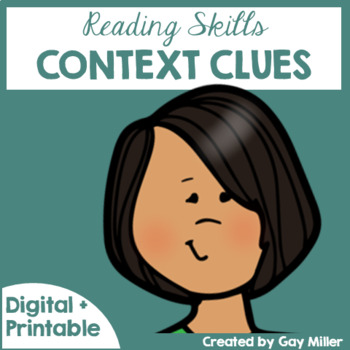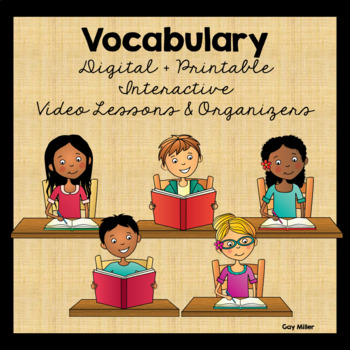
One of the most essential skills for reading comprehension is using context clues, and incorporating context clues anchor charts can be especially effective. Context clues are words or sentences that help us determine the meaning of new or unfamiliar words. Using anchor charts can improve students’ vocabulary, help them understand the text better, and enhance their enjoyment of reading.
In this blog post, you will find some fun and engaging activities that will help you teach context clues to your students. These activities are aligned with the Common Core Standards for Context Clues for grades 5, 6, and 7. These standards require students to use context clues such as cause and effect relationships, comparisons, word position, and function to determine the meaning of a word or phrase.
Be sure to get the handout. It includes the printables and links to the video lesson, Google Slides, and Boom Learning Decks that you will need to complete some of the activities listed here.
Context Clues Activities
Activity #1: Hook for Introducing Context Clues

Context clues help students figure out the meaning of new words. Teachers can make learning context clues fun by playing some games. Here are some games that I like to use to start the lesson:
Mystery Objects:
I put some objects in brown paper bags and ask one student to describe what is inside each bag. The other students try to guess the thing based on the description. We do this for four or five bags. Then we talk about how this is like using context clues to understand unknown words in a sentence.
Baloney (Henry P) is a fun book to introduce context clues. Henry uses make-believe words in a long excuse explaining why he is late for school. Students use context clues to figure out the meanings of unknown words.
Cloze Activity: I give the students some sentences with one word missing. They have to fill in the blanks as fast as they can. We see who can complete the most sentences in a minute or two. Then we discuss how they knew what the missing word was. We compare this to finding an unfamiliar word while reading.
Some examples of Cloze Sentences from this activity are:
On the ____________, we had a picnic and watched the fireworks.
Martha had to stay in bed when she had a ____________ of 102.
Activity #2: Anchor Chart

An anchor chart is a poster students can reference during a lesson. You can see the ones I created in the photos.
These anchor charts explain and give examples of five types of context clues:
- definition
- example
- cause and effect
- restatement
- contrast
Activity #3: Video Lesson and Organizer

This activity is a sample from Context Clues Lessons and Activities. This sample teaches students how to use contrast context clues. These are clues that show the opposite or different meaning of a word.
For example:
Daniel was apprehensive about mountain climbing, but Sam had no worries at all.
The words no worries at all are contrast clues. They tell us that apprehensive means the opposite of no worries at all. So, apprehensive means feeling nervous or scared.
This sample has two parts:
- A page of matching and multiple choice questions about contrast context clues
- A video lesson with an organizer
This activity introduces students to using contrasting context clues. This mini-lesson is a vocabulary-building exercise for upper elementary and middle school students.
In this lesson, students watch the video. The video goes over the definition of contrasting context clues and two examples. Next, students pause the video to complete either the digital or printable organizer. After completing the organizer, students continue watching the video to check their responses. This mini activity is an excellent introduction to a context clues lesson.
Assign these activities through Google Classroom for distance or classroom learning.

Activity #4: Context Clues Handout

Now that students understand how knowing about different context clues will aid their understanding, provide them with the reference chart in the handout. This chart covers five common types of context clues, with examples of each.
Students can use the chart to help them understand new words by looking at the context clues around them.
Activity #5: Interactive Context Clues Games

If you’re looking for a fresh way to teach context clues, these interactive JavaScript games bring vocabulary to life. Students start with pyramid puzzles that challenge them to unscramble related words and identify the common theme using context. Then they move into a fast-paced Bump Game, where each turn reveals a sentence and players race to match it with the correct vocabulary word on the gameboard. With themes like space, cooking, pirates, insects, and magic, the games are both skill-building and engaging – perfect for upper elementary learners who love movement, strategy, and surprise.
Activity#6 – Free Activities from Book Units Teacher
You can find more context clues practice exercises on my website. Some of these exercises use words from novels, but you don’t need to read the books to do the activities.
To get the links for these activities, download the handout.
- Three board games based on the novel Walk Two Moons contain twelve cloze sentences each for students to find the missing words. Students use context clues to determine which word from the word bank goes in the sentence.
- Bump is a fun game where you bump your opponent off the board by answering questions correctly. These games help students practice context clues using sentences from the novels The One and Only Bob and Al Capone Does My Shirts. Playing Bump is a fun way for students to practice. You can play the games online or print them out.
- In this lesson activity, students use context clues to determine the meanings of mythological, biblical, literary, and historical allusions. This lesson is a free sample from my Vocabulary Digital + Printable Interactive Video Lessons & Organizers on TPT.
Activity #7: PowerPoint Lessons

PowerPoint 1:
This PowerPoint has three parts. The first part teaches students about context clues, such as definition, restatement\comparison, example, cause and effect, and contrast. In the second part, students learn about affixes, parts of words that change meaning, such as prefixes and suffixes. The third part shows students how to use resources like dictionaries and thesauruses to look up unfamiliar words.
You can use the handout from Activity #4 with this PowerPoint.
PowerPoint 2:
The second PowerPoint contains 17 cloze sentences. Students will see sentences containing missing words one at a time. They must determine which word belongs in the blank from a word bank. Students receive immediate feedback by clicking the mouse to show the answers.
Activity #8: Cloze Poems and Definitions

The Wizard of Oz Task Cards or Peter Pan Task Cards are sets of 24 task cards with multiple-choice questions based on sentences from the novels. The questions ask students to choose the definition of a bolded word in the sentence. Students can figure out the meaning of an unfamiliar word by using context clues.
Turn these task cards into a fun activity with Scoot.
Scoot Instructions:
Scoot is a game that you can play with a set of task cards. You need one task card for each student’s desk. You also need a sheet for each student to record their answers on.
To play Scoot, you put one task card on each desk in numerical order. Each student reads the question on their card and writes the answer on their sheet. After a specific time (about 1 minute), you signal the students to move to the next desk. They do this until they have answered all the task cards.
Scoot is a fun way to review context clues with your students.
Context clues are a powerful tool for reading comprehension and vocabulary development. By teaching your students how to use context clues, you will help them become better readers and learners.
Thank you for reading this blog post. If you have any questions or feedback, please leave a comment below. I would love to hear from you. Happy teaching! 😊
See the products that inspired this post.

This unit contains nine video lessons with organizers plus seven activities to practice the skills taught.

Check out Vocabulary Digital + Printable Interactive Video Lessons & Organizers on TPT. This unit includes the videos and organizers without practice. They are great for unit hooks or reviews.


